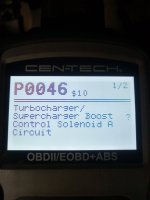Hey guys, I am working on a truck for a guy and it's a 2005 lly. It kept blowing off the y bridge elbow, because it had a cheap egr delete on it. I order the y bridge strap from pro fab and put on for him. That fixed the blowing off issue, but I noticed it was way over boosting. (Probably why it kept blowing the elbow off). I pulled up the live data and noticed the map was at 4.5 psi all the time. I checked the sensor and noticed that the plug was broke off. So, I bought a new sensor and installed it (skp brand). Now, at idle or wot it reads 37 psi all the time. No change, no boost, no turbo sweep and no power. So, I disconnected the wiring connector and probed across from the 5v ref to low ref on the connector and got a solid 5.06 volts. That would mean the ground and 5v ref is good I assume. That can only mean it's a bad map sensor, right? Another thing I wonder is if they sold me the barometric sensor instead of the map. However, the parts guy insisted that either one would work for the map. Anyways, if I have 5v ref and solid ground, then it has to be a faulty part, right? Or am I missing something? Gm wants 180 bucks for their Ac Delco brand. I have already placed an order at the dealer for one, but if it don't fix it, then I have wasted some money. Could it still be a problem in the wiring?
Edit- also, I forgot to ask, someone said you should change the barometric sensor with the map as a set. Is that true? If the baro sensor is still good, why does it have to be changed? I could see if it was a programmable part, but they aren't as far as I know.
Edit- also, I forgot to ask, someone said you should change the barometric sensor with the map as a set. Is that true? If the baro sensor is still good, why does it have to be changed? I could see if it was a programmable part, but they aren't as far as I know.
Last edited:








